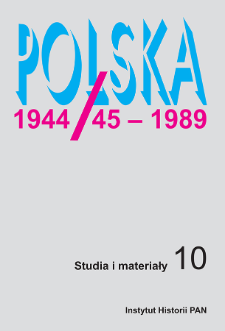- Search in all Repository
- Literature and maps
- Archeology
- Mills database
- Natural sciences
Advanced search
Advanced search
Advanced search
Advanced search
Advanced search

Object
Title: Środowisko twórcze wobec zmian w Polsce w 1989 roku
Subtitle:
Polska 1944/45-1989 : studia i materiały 10 (2011)
Contributor:
Instytut Historii Polskiej Akademii Nauk
Publisher:
Place of publishing:
Description:
Type of object:
Abstract:
The artistic community in Poland followed all changes occurring in the USSR with great interest, starting from the moment Mikhail Gorbachev was elected First Secretary of the Central Committee of the Communist Party of the Soviet Union. At that time, the Polish authorities regarded artists, and especially writers, as an important opinion-forming community. On the one hand, the documents produced by the Security Service illustrated the inertia of the official Association of Polish Writers, imposed on the community after 1983, on the other, the endeavours of independent literary groups to reactivate the Pen Club and to establish a network of independent literary clubs and societies. Former members of the APW from before 1983 tried to create new associations, as illustrated by the attempt of the literary communities from Łódź and Wrocław. In Łódź in March of 1988 a “Cultural Society of Łódź” was established, and in Wrocław – a Trade Union of Polish Writers of the Independent Self-governing Trade Union “Solidarity”. Similar initiatives were undertaken towards other artistic communities throughout Poland.Due to the observable decay of the official authorities (the administration, party and rationed associations), the only competent structure was the Ministry of Internal Affairs, able to control operationally independent artistic communities. That control was exercised till the very end of the political system. In the first quarter of 1990 the Department for Protection of the Constitutional Order of the State at the Ministry of Internal Affairs and its local branches consistently gathered the information about an atmosphere and frame of mind among artists. Opinions were noted of the unification of Germany and the whole array of Polish-German matters (the issue of borders and integrity of the Western Polish frontier), Lithuanian’s independence and economic crisis together with Leszek Balcerowicz’ reforms. The artistic communities anxiously awaited changes in the cultural situation in Poland.
Relation:
Polska 1944/45-1989 : studia i materiały
Volume:
Start page:
End page:
Detailed Resource Type:
Format:
Resource Identifier:
oai:rcin.org.pl:59716 ; 2450-8357
Source:
IH PAN, sygn. B.155/10 Podr. ; IH PAN, sygn. B.156/10 ; click here to follow the link
Language:
Language of abstract:
Rights:
Licencja Creative Commons Uznanie autorstwa-Bez utworów zależnych 4.0
Terms of use:
Zasób chroniony prawem autorskim. [CC BY-ND 4.0 Międzynarodowe] Korzystanie dozwolone zgodnie z licencją Creative Commons Uznanie autorstwa-Bez utworów zależnych 4.0, której pełne postanowienia dostępne są pod adresem: ; -
Digitizing institution:
Instytut Historii Polskiej Akademii Nauk
Original in:
Biblioteka Instytutu Historii PAN
Access:
Object collections:
- Digital Repository of Scientific Institutes > Partners' collections > Institute of History PAS > Serials
- Digital Repository of Scientific Institutes > Partners' collections > Institute of History PAS > Institute Publications
- Digital Repository of Scientific Institutes > Partners' collections > Institute of History PAS > Institute Publications > Journals
- Digital Repository of Scientific Institutes > Partners' collections > Institute of History PAS > Institute Publications > Journals > Polska 1944/45-1989
- Digital Repository of Scientific Institutes > Literature > Journals/Articles
Last modified:
Oct 2, 2020
In our library since:
Sep 21, 2016
Number of object content downloads / hits:
162
All available object's versions:
https://rcin.org.pl./publication/78864
Show description in RDF format:
Show description in RDFa format:
Show description in OAI-PMH format:
| Edition name | Date |
|---|---|
| Ligarski, Sebastian (1975- ), Środowisko twórcze wobec zmian w Polsce w 1989 roku | Oct 2, 2020 |
Objects Similar
Przeperski, Michał (1986– )
Słabek, Henryk (1928–2020)
Ligarski, Sebastian (1975– )
Ligarski, Sebastian (1975– )
Kosiński, Krzysztof (1974– )
Ligarski, Sebastian (1975– ) Majchrzak, Grzegorz (1969– )
Sudziński, Ryszard (1945– )
Duraczyński, Eugeniusz (1931–2020)

 INSTYTUT ARCHEOLOGII I ETNOLOGII POLSKIEJ AKADEMII NAUK
INSTYTUT ARCHEOLOGII I ETNOLOGII POLSKIEJ AKADEMII NAUK
 INSTYTUT BADAŃ LITERACKICH POLSKIEJ AKADEMII NAUK
INSTYTUT BADAŃ LITERACKICH POLSKIEJ AKADEMII NAUK
 INSTYTUT BADAWCZY LEŚNICTWA
INSTYTUT BADAWCZY LEŚNICTWA
 INSTYTUT BIOLOGII DOŚWIADCZALNEJ IM. MARCELEGO NENCKIEGO POLSKIEJ AKADEMII NAUK
INSTYTUT BIOLOGII DOŚWIADCZALNEJ IM. MARCELEGO NENCKIEGO POLSKIEJ AKADEMII NAUK
 INSTYTUT BIOLOGII SSAKÓW POLSKIEJ AKADEMII NAUK
INSTYTUT BIOLOGII SSAKÓW POLSKIEJ AKADEMII NAUK
 INSTYTUT CHEMII FIZYCZNEJ PAN
INSTYTUT CHEMII FIZYCZNEJ PAN
 INSTYTUT CHEMII ORGANICZNEJ PAN
INSTYTUT CHEMII ORGANICZNEJ PAN
 INSTYTUT FILOZOFII I SOCJOLOGII PAN
INSTYTUT FILOZOFII I SOCJOLOGII PAN
 INSTYTUT GEOGRAFII I PRZESTRZENNEGO ZAGOSPODAROWANIA PAN
INSTYTUT GEOGRAFII I PRZESTRZENNEGO ZAGOSPODAROWANIA PAN
 INSTYTUT HISTORII im. TADEUSZA MANTEUFFLA POLSKIEJ AKADEMII NAUK
INSTYTUT HISTORII im. TADEUSZA MANTEUFFLA POLSKIEJ AKADEMII NAUK
 INSTYTUT JĘZYKA POLSKIEGO POLSKIEJ AKADEMII NAUK
INSTYTUT JĘZYKA POLSKIEGO POLSKIEJ AKADEMII NAUK
 INSTYTUT MATEMATYCZNY PAN
INSTYTUT MATEMATYCZNY PAN
 INSTYTUT MEDYCYNY DOŚWIADCZALNEJ I KLINICZNEJ IM.MIROSŁAWA MOSSAKOWSKIEGO POLSKIEJ AKADEMII NAUK
INSTYTUT MEDYCYNY DOŚWIADCZALNEJ I KLINICZNEJ IM.MIROSŁAWA MOSSAKOWSKIEGO POLSKIEJ AKADEMII NAUK
 INSTYTUT PODSTAWOWYCH PROBLEMÓW TECHNIKI PAN
INSTYTUT PODSTAWOWYCH PROBLEMÓW TECHNIKI PAN
 INSTYTUT SLAWISTYKI PAN
INSTYTUT SLAWISTYKI PAN
 SIEĆ BADAWCZA ŁUKASIEWICZ - INSTYTUT TECHNOLOGII MATERIAŁÓW ELEKTRONICZNYCH
SIEĆ BADAWCZA ŁUKASIEWICZ - INSTYTUT TECHNOLOGII MATERIAŁÓW ELEKTRONICZNYCH
 MUZEUM I INSTYTUT ZOOLOGII POLSKIEJ AKADEMII NAUK
MUZEUM I INSTYTUT ZOOLOGII POLSKIEJ AKADEMII NAUK
 INSTYTUT BADAŃ SYSTEMOWYCH PAN
INSTYTUT BADAŃ SYSTEMOWYCH PAN
 INSTYTUT BOTANIKI IM. WŁADYSŁAWA SZAFERA POLSKIEJ AKADEMII NAUK
INSTYTUT BOTANIKI IM. WŁADYSŁAWA SZAFERA POLSKIEJ AKADEMII NAUK


































